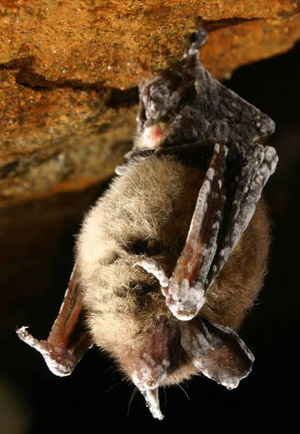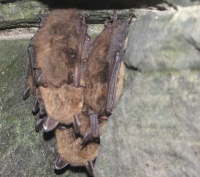- Home
- About S&T
- Taxa/Organisms
- Ecosystems
- Issues
- Methods & Tools
- Reports & Publications
- Location
- Search
Publisher: USGS | Science Center: Patuxent Wildlife Research Center (PWRC, Laurel) | Format: URL
www.pwrc.usgs.gov — Information about ecotoxicological exposure and its effects on terrestrial vertebrates residing in estuarine and coastal habitats like the Atlantic, Gulf and Pacific Coasts, Alaska and Hawaii, as well as the Great Lakes. These vertebrates include birds, mammals, amphibians and reptiles. The data is a compilation of results from computerized More...

March 25 2008 | Publisher: Other (Bat Conservation International) | Format: URL
www.batcon.org — Hibernating bats are dying by the tens of thousands in the northeastern United States, and a growing circle of top scientists is anxiously trying to figure out why. The mystery affliction, reported in New York, Vermont and Massachusetts, is dubbed "white-nose syndrome" because many affected bats had visible halos of white fungus around their More...

2001 | Publisher: USGS | Science Center: Upper Midwest Environmental Sciences Center (UMESC, LaCrosse) | Format: URL
www.umesc.usgs.gov — Research at the Upper Midwest Environmental Center, which gathered detailed observations on tree swallow nesting success and contaminant concentrations in 1998-2000, to guide EPA and the U.S. Fish and Wildlife Service in effectively managing the risk of chemical contaminants to wildlife and the environment.

Publisher: USGS | Format: URL
www.usgs.gov — It has been estimated that over 100,000 bats have died in the northeast due to a mysterious white fungus called White-Nose Syndrome (WNS). Scientists are finding within caves and mines a large number of bats with a white fungus on their muzzles and other parts of their bodies. It is uncertain as to how this fungus is being transmitted and its More...

Publisher: Other Federal Agency (United States Fish and Wildlife Service (USFWS)) | Format: URL
www.fws.gov — Tens of thousands of hibernating bats died this winter in the northeast, and for unknown reasons. In and around caves and mines in eastern and upstate New York, Vermont, western Massachusetts, and northwestern Connecticut, biologists found sick, dying and dead bats in unprecedented numbers. In just eight of the affected New York caves, mortality More...

Publisher: USGS | Science Center: Fort Collins Science Center (FORT, Ft. Collins) | Format: URL
www.fort.usgs.gov — During the winter of 2006 or 2007, an affliction of unknown origin dubbed "White-Nose Syndrome" (WNS) began devastating colonies of hibernating bats in a small area around Albany, New York. Colonies of hibernating bats were reduced 81-97 percent at the affected caves and mines that were surveyed. Since then, White-Nose Syndrome has been detected More...

Publisher: USGS | Science Center: National Wildlife Health Center (NWHC, Madison) | Format: URL
www.nwhc.usgs.gov — The condition in bats known as white-nose syndrome (WNS) was first noted among dead and hibernating bats found in caves near Albany, New York, by the New York State Department of Environmental Conservation beginning in February 2007. Affected bats appeared to have a white substance on their heads and wings. In early 2008, "white-nosed" bats were More...

Publisher: USGS | Science Center: National Wildlife Health Center (NWHC, Madison) | Format: URL
www.nwhc.usgs.gov — The condition in bats known as "white-nose syndrome" (WNS) was first noted among dead and hibernating bats found in caves near Albany, New York, by the New York State Department of Environmental Conservation beginning in February 2007. Affected bats appeared to have a white substance on their heads and wings. In early 2008, "white-nosed" bats were More...

Publisher: USGS | Science Center: Upper Midwest Environmental Sciences Center (UMESC, LaCrosse) | Format: URL
www.umesc.usgs.gov — Little is known about the movements of common loons (Gavia immer) during migrations and on wintering ranges in coastal waters. This information is needed to formulate effective regional and national conservation strategies. UMESC has collaborated with regional partners in the use of satellite telemetry to study the movements of common loons More...

Publisher: USGS | Science Center: Northern Prairie Wildlife Research Center (NPWRC, Jamestown) | Format: URL
www.npwrc.usgs.gov — This resource is a species profile of the purple loosestrife (Lythrum salicaria), which is considered an invasive plant species. Its displacement of native species in wetlands has led to the loss of suitable habitat for wildlife. L. salicaria is the only reddish-purple flowered plant to develop massive monospecific blocks of showy floral displays More...

Publisher: USGS | Science Center: Leetown Science Center (LSC, Kearneysville) | Format: URL
www.lsc.usgs.gov — Freshwater mussels are declining rapidly in response to habitat degradation associated with anthropogenic changes. Williams et. al. (1993) reported that 213 of the 297 recognized taxa are considered endangered, threatened, or of special concern. There is a documented need for BRD centers to provide guidance on freshwater mussel ecology in general, More...

Publisher: USGS | Science Center: Patuxent Wildlife Research Center (PWRC, Laurel) | Format: URL
www.pwrc.usgs.gov — From the website: "This website provides a resource for learning breeding calls of frogs and toads in the eastern United States and Canada. This site provides links to a frog call lookup tool, public quizzes for identifying frog calls in states and provinces through amphibian monitoring programs such as Frogwatch USA, NAAMP, Parks/Refuges by More...
